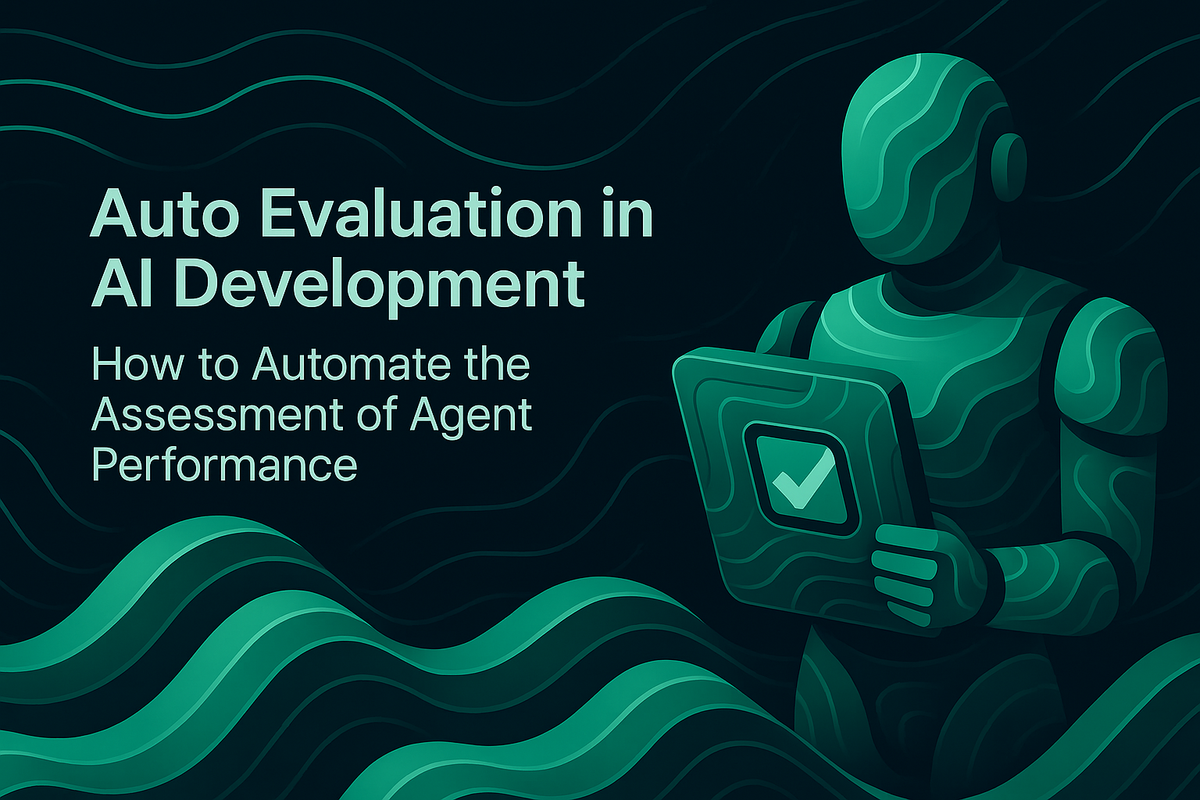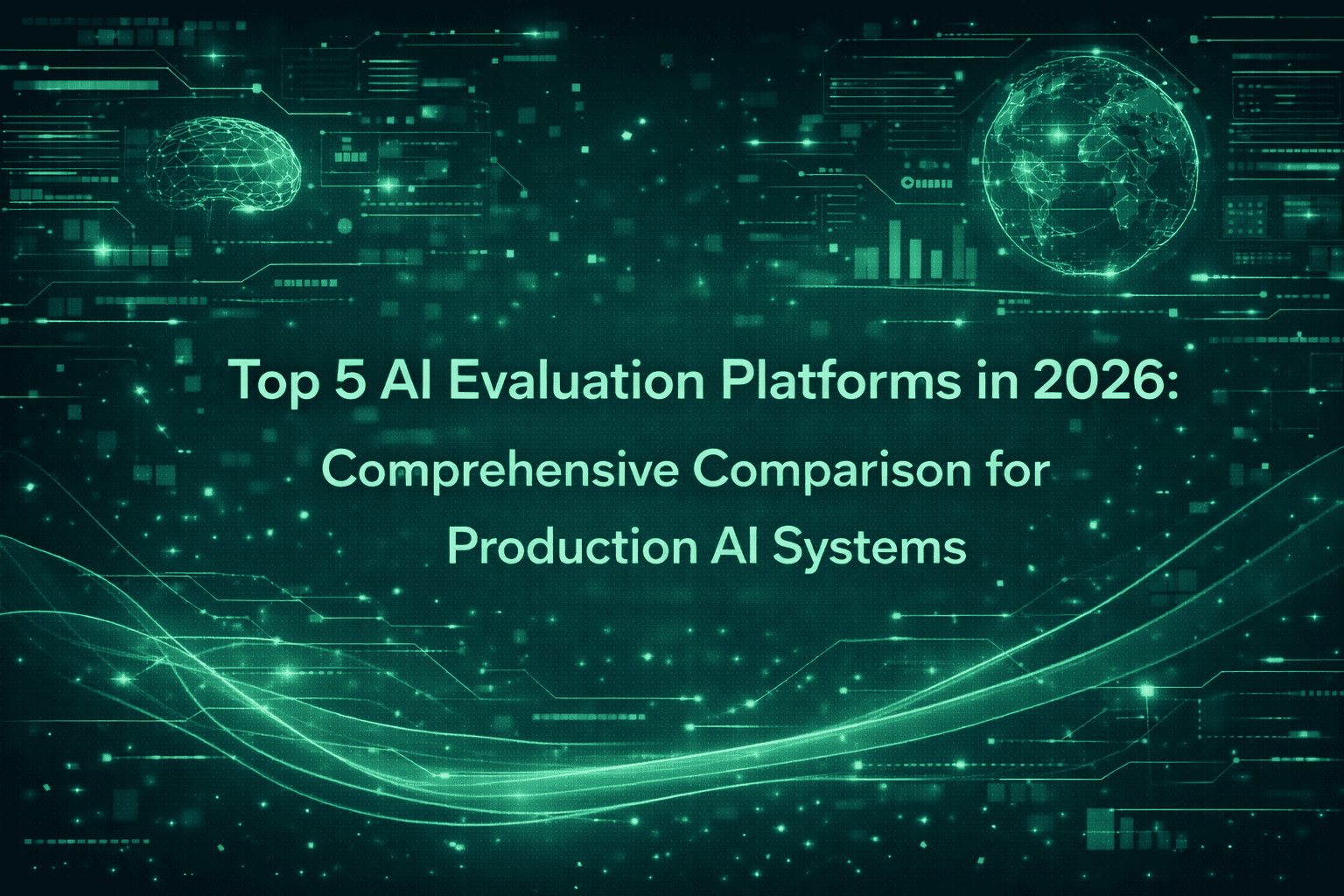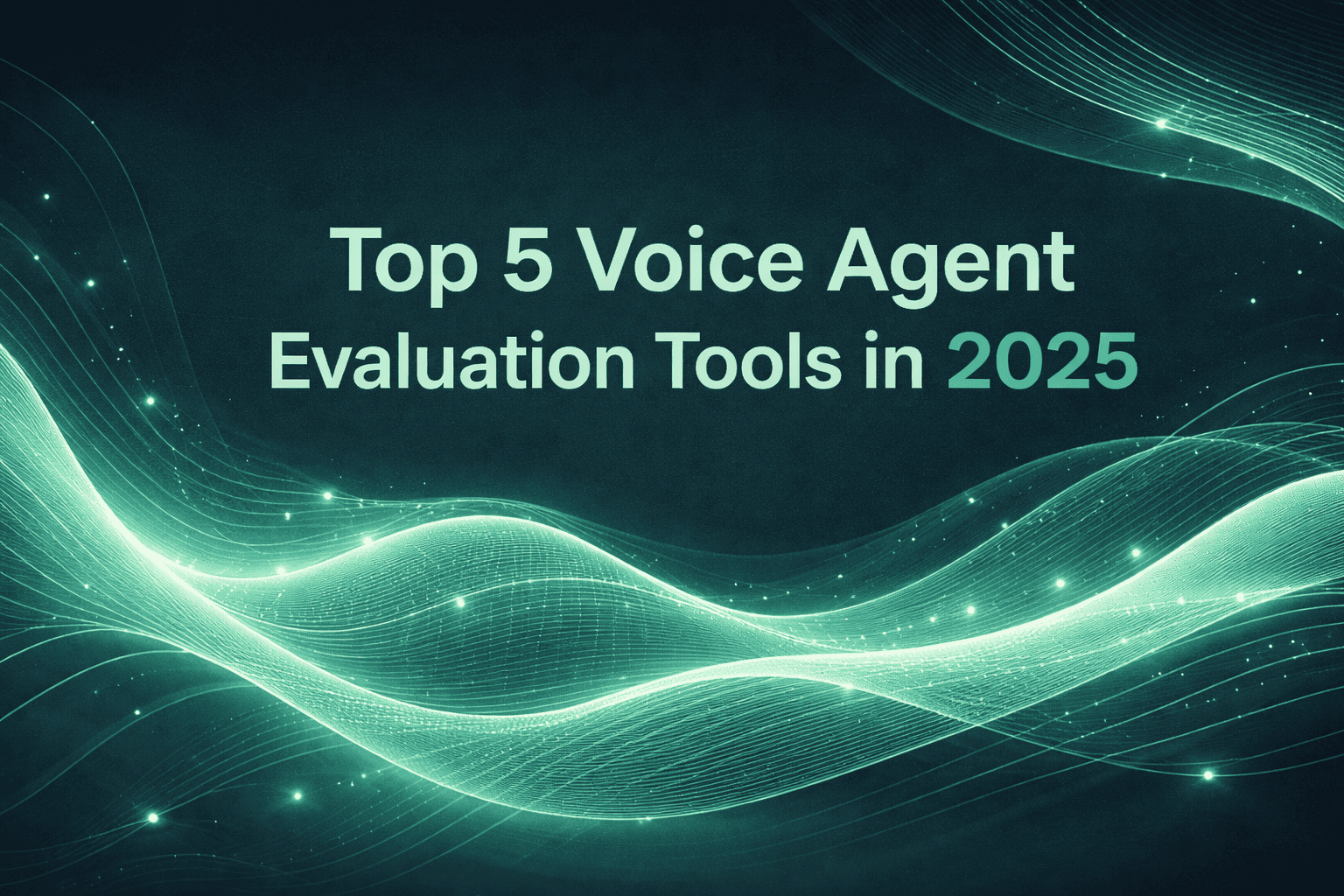Auto Evaluation in AI Development: How to Automate the Assessment of Agent Performance

Deploying AI agents to production presents a critical challenge: ensuring consistent quality at scale. As AI systems handle thousands of interactions daily, manual quality assessment becomes impractical and introduces bottlenecks that slow down iteration cycles. Auto evaluation (the automated assessment of AI agent performance using predefined metrics and criteria) has emerged as a fundamental practice for teams building reliable AI applications.
This comprehensive guide examines how auto evaluation works, why it matters for AI development, and how to implement automated assessment systems that maintain quality standards without sacrificing development velocity.
Understanding Auto Evaluation in AI Systems
Auto evaluation refers to the systematic, automated measurement of AI agent outputs against defined quality criteria. Unlike manual review processes where human annotators assess each interaction, auto evaluation uses programmatic rules, statistical methods, and AI-based judges to continuously monitor agent performance.
The foundation of effective auto evaluation lies in defining clear metrics that align with business objectives and user expectations. These metrics typically fall into several categories:
Accuracy and correctness metrics measure whether the agent produces factually accurate responses and follows specified workflows correctly. For customer support agents, this might include tracking resolution accuracy or adherence to company policies.
Quality and relevance metrics assess the appropriateness and helpfulness of agent responses. These evaluations often examine whether responses directly address user queries, maintain consistent tone, and provide actionable information.
Performance metrics track operational efficiency indicators such as response latency, token usage, and completion rates. These measurements help teams optimize costs while maintaining quality standards.
Safety and compliance metrics ensure agents avoid generating harmful content, maintain appropriate boundaries, and comply with regulatory requirements. This becomes particularly critical for agents handling sensitive domains like healthcare or financial services.
The strategic implementation of auto evaluation enables teams to detect quality regressions quickly, identify patterns in agent behavior, and make data-driven decisions about model selection and prompt engineering strategies.
The Business Case for Automated Agent Assessment
Organizations building AI applications face mounting pressure to ship features rapidly while maintaining reliability. Manual quality assurance processes create significant friction in this equation. A team reviewing even 100 agent interactions daily requires substantial human resources, introduces review latency, and struggles with consistency across different reviewers.
Auto evaluation addresses these challenges by enabling continuous quality monitoring at scale. When properly implemented, automated assessment systems can evaluate thousands of interactions per hour, providing immediate feedback on agent performance and flagging potential issues before they impact users.
The impact extends beyond operational efficiency. Teams using automated evaluation frameworks report 5x faster iteration cycles, as developers receive immediate feedback on changes rather than waiting for manual review cycles. This acceleration proves particularly valuable during prompt engineering work, where rapid experimentation drives quality improvements.
Cost considerations also favor automation. While building robust evaluation systems requires upfront investment, the ongoing operational costs prove significantly lower than maintaining large manual review teams. Organizations processing millions of agent interactions monthly find that automated evaluation becomes economically necessary at scale.
Perhaps most importantly, auto evaluation enables objective, consistent measurement. Human reviewers introduce variability based on individual judgment, fatigue, and interpretation of guidelines. Automated systems apply criteria uniformly, generating reliable metrics that teams can trust for decision-making.
Implementing Auto Evaluation: Core Components
Successful auto evaluation systems comprise several interconnected components working together to assess agent quality comprehensively.
Defining Evaluation Criteria
The first step involves translating business requirements into measurable criteria. This process requires collaboration between product teams, who understand desired outcomes, and engineering teams, who implement measurement logic.
Effective evaluation criteria exhibit several characteristics. They must be specific and measurable, avoiding vague terms like "good" or "appropriate" in favor of concrete definitions. They should be aligned with user value, focusing on aspects that genuinely impact user experience rather than arbitrary technical metrics. Finally, criteria must be implementable at scale, meaning they can be assessed automatically without requiring human judgment for every instance.
Consider a customer support agent. Useful evaluation criteria might include:
- Query understanding: Does the agent correctly identify the user's intent?
- Response completeness: Does the response address all aspects of the user's question?
- Tone appropriateness: Does the response maintain the desired communication style?
- Action completion: Did the agent successfully complete requested tasks?
Each criterion requires a corresponding evaluation method, which might be deterministic (rule-based), statistical, or AI-based.
Selecting Evaluation Methods
Modern auto evaluation leverages multiple assessment approaches, each suited to different types of quality criteria.
Deterministic evaluators apply explicit rules to measure agent outputs. These work well for objective, binary assessments. For example, checking whether a response contains required information, verifies that specific API calls occurred, or confirms adherence to formatting requirements. Deterministic evaluators provide reliable, reproducible results but cannot assess nuanced quality aspects.
Statistical evaluators measure aggregate patterns across multiple interactions. These methods prove valuable for detecting drift in agent behavior, identifying outliers, and tracking performance trends over time. Common statistical evaluations include monitoring response length distributions, measuring consistency in similar scenarios, and detecting anomalous patterns that deviate from established baselines.
AI-based evaluators use language models to assess subjective quality dimensions that resist simple rule-based measurement. The LLM-as-a-judge approach enables evaluation of aspects like tone, helpfulness, and contextual appropriateness. When implementing AI-based evaluators, teams must carefully validate that the judge models align with human preferences through correlation studies comparing automated scores with human annotations.
The most robust evaluation systems combine multiple methods, using deterministic checks for clear-cut criteria, statistical analysis for pattern detection, and AI-based judges for nuanced quality assessment.
Establishing Evaluation Infrastructure
Implementing auto evaluation at scale requires dedicated infrastructure for executing evaluations, storing results, and surfacing insights to development teams.
Online evaluation systems run assessments against production traffic, providing real-time visibility into agent performance. This approach enables rapid detection of quality issues affecting live users. However, online evaluation introduces latency considerations, as evaluation logic executes within the critical path of user interactions.
The infrastructure must support flexible evaluation granularity. Modern AI applications often involve multi-step workflows where agents perform multiple reasoning steps, make tool calls, and generate intermediate outputs. Effective evaluation systems allow teams to assess quality at different levels, individual LLM calls, tool usage, complete user interactions, or full conversational sessions.
Maxim's observability platform exemplifies this approach, enabling evaluation at the session, trace, or span level. This granularity proves essential for debugging complex agent failures, where issues might originate from a specific step in a multi-stage workflow rather than the final output.
Setting Up Auto Evaluation: Practical Implementation
Implementing auto evaluation involves configuring evaluation rules, integrating them into agent workflows, and establishing monitoring practices that turn evaluation data into actionable insights.
Configuring Online Evaluations
Online evaluations run automatically against production logs, providing continuous quality monitoring without requiring manual test execution. The configuration process involves several key decisions.
Teams must first select which interactions to evaluate. Evaluating every production interaction provides maximum coverage but increases computational costs and latency. Many teams adopt sampling strategies, evaluating a representative subset of traffic while flagging specific scenarios for comprehensive assessment, such as user-reported issues, new feature deployments, or edge cases identified through user behavior analysis.
The evaluation timing represents another critical consideration. Synchronous evaluation executes during the interaction, enabling real-time intervention if quality thresholds are violated. This approach suits scenarios where preventing poor outputs justifies added latency. Asynchronous evaluation runs after interactions complete, minimizing user-facing latency while still providing rapid feedback on quality trends.
Maxim supports both approaches, allowing teams to configure evaluation timing based on specific requirements. Synchronous evaluation enables immediate quality gates, while asynchronous assessment supports comprehensive analysis without impacting user experience.
Implementing Node-Level Evaluation
Complex AI agents often involve multi-step reasoning processes, tool calls to external systems, and iterative refinement of outputs. Evaluating only the final response misses critical insights into where failures occur within these workflows.
Node-level evaluation enables assessment at specific points within agent execution. This granularity proves invaluable for debugging and optimization. Consider a retrieval-augmented generation (RAG) system: separate evaluations might assess retrieval quality (did the system find relevant documents?), context utilization (did the agent properly use retrieved information?), and response quality (is the final output accurate and helpful?).
Implementing node-level evaluation requires instrumenting agent code to capture intermediate states and outputs. Modern observability platforms use distributed tracing concepts, where each operation receives a unique identifier and records metadata about its execution. Evaluation logic then references these identifiers to assess specific workflow components.
This approach enables precise debugging. When an agent produces poor outputs, node-level evaluation data reveals exactly which step failed, whether retrieval found irrelevant documents, the reasoning process misinterpreted context, or the response generation hallucinated information not present in the context.
Balancing Automation with Human Oversight
While automation provides scalability, human judgment remains essential for validating evaluation quality and handling edge cases that resist automated assessment. The most effective quality programs combine automated evaluation with strategic human review.
Human annotation workflows complement auto evaluation in several ways. Human reviewers validate that automated evaluators correlate with actual quality by reviewing samples that automated systems rate highly or poorly. This validation ensures evaluation logic remains aligned with human preferences as agents evolve.
Human annotation also generates training data for improving AI-based evaluators. By collecting expert judgments on challenging cases, teams can fine-tune judge models to better reflect domain-specific quality criteria and handle nuanced scenarios where generic evaluators struggle.
The key lies in using automation to handle the bulk of quality assessment while directing human expertise toward validation, edge case analysis, and continuous improvement of evaluation systems themselves.
Operationalizing Auto Evaluation: Monitoring and Response
Collecting evaluation data provides value only when teams actively use it to maintain and improve agent quality. Effective operationalization requires establishing monitoring practices, alert systems, and workflows that translate evaluation insights into action.
Establishing Quality Baselines and Thresholds
Meaningful quality monitoring requires context. A 90% accuracy rate might represent excellent performance for one agent but signal serious degradation for another. Teams must establish baseline performance metrics during initial deployment and define thresholds that trigger investigation.
Baseline establishment involves running comprehensive evaluations across diverse scenarios during the development phase. This process generates distributions for key metrics, revealing typical performance ranges and identifying metrics with high variability that require careful monitoring.
Threshold configuration then defines acceptable performance bounds. Rather than single fixed values, effective thresholds often use statistical approaches, flagging anomalies when metrics deviate significantly from historical norms. This approach adapts to gradual performance improvements while still catching sudden regressions.
Configuring Alerts and Notifications
Alert systems translate evaluation data into timely notifications that enable rapid response to quality issues. Effective alerting requires careful configuration to balance sensitivity (catching real issues) with specificity (avoiding alert fatigue from false positives).
Teams typically configure alerts for several scenarios:
Threshold violations trigger when key metrics fall outside acceptable ranges. For example, alerting when response accuracy drops below 85% or when hallucination rates exceed 2% of interactions.
Trend detection identifies gradual quality degradation that might not violate absolute thresholds but signals concerning patterns. Statistical process control methods can detect significant shifts in metric distributions before they impact user satisfaction.
Volume anomalies catch unusual patterns in agent usage or behavior. Sudden spikes in error rates, unexpected changes in query types, or dramatic shifts in conversation length distributions often indicate integration issues or changing user needs requiring attention.
Alert routing ensures notifications reach appropriate team members. Critical production issues might page on-call engineers immediately, while gradual quality trends generate daily summaries for product teams to review during planning sessions.
Building Response Workflows
Alerts provide value only when they trigger effective responses. Teams building reliable AI applications establish clear workflows for investigating and resolving quality issues identified through auto evaluation.
The investigation process typically begins with examining evaluation data for the flagged interactions. Rich observability data (including conversation context, agent reasoning traces, and evaluation scores across multiple criteria) enables engineers to quickly identify root causes. Was the issue caused by prompt changes, model updates, external API failures, or unexpected user inputs?
Resolution approaches vary based on issue type. Prompt engineering problems might require reverting recent changes or refining instructions. Model selection issues could trigger switching to alternative providers or adjusting temperature parameters. Integration failures often require updating API credentials or adjusting error handling logic.
Post-resolution, teams update evaluation criteria and test sets to prevent regression. Issues that escaped detection reveal gaps in existing evaluation coverage, driving continuous improvement of quality monitoring systems.
Advanced Auto Evaluation Strategies
As AI applications mature, teams adopt sophisticated evaluation approaches that provide deeper insights and enable more nuanced quality assessment.
Multi-Dimensional Quality Scoring
Simple pass/fail evaluations often miss important nuances in agent quality. Advanced implementations use multi-dimensional scoring systems that assess multiple quality aspects independently.
Consider customer support agents. Comprehensive evaluation might independently score:
- Accuracy: factual correctness of information provided
- Completeness: whether all user questions received answers
- Efficiency: whether the agent resolved issues with minimal back-and-forth
- Tone: appropriateness of communication style
- Compliance: adherence to company policies and regulatory requirements
Independent scoring enables nuanced analysis. An interaction might score highly on accuracy but poorly on efficiency, suggesting opportunities to optimize agent workflows without compromising correctness. This granularity drives targeted improvements rather than generic "make it better" feedback.
Comparative Evaluation and A/B Testing
Quality exists as a relative concept, agent performance matters most in comparison to alternatives. Comparative evaluation systematically assesses multiple agent variants against the same scenarios, enabling objective selection of optimal configurations.
Teams building production agents constantly experiment with different prompts, models, and parameters. Comparative evaluation frameworks run these variants against standardized test sets, measuring quality differences across key metrics. This approach removes subjective judgment from decision-making, replacing it with empirical data about relative performance.
A/B testing extends this concept to production traffic. Teams deploy multiple agent variants to different user segments, using auto evaluation to measure quality differences in live interactions. This real-world validation ensures that improvements observed in testing translate to better user experiences in production.
Continuous Evaluation and Dataset Evolution
Agent evaluation should evolve alongside the applications themselves. Early deployment focuses on basic functionality and common scenarios. As products mature, evaluation must expand to cover edge cases, emerging user needs, and newly identified failure modes.
Successful teams treat evaluation datasets as living artifacts requiring continuous curation. Production logs provide valuable material for dataset expansion, particularly interactions where agents struggled or users expressed dissatisfaction. These real-world challenges become test cases ensuring future versions handle similar situations correctly.
Dataset evolution also addresses distribution shift. User needs and interaction patterns change over time, potentially rendering older test cases less representative of actual usage. Periodic dataset refreshes (removing outdated scenarios and adding recent interaction patterns) ensure evaluation remains relevant.
Building Reliable AI Agents with Automated Quality Assurance
Auto evaluation represents a fundamental shift from reactive quality management to proactive quality engineering. Rather than discovering issues after users report problems, teams gain continuous visibility into agent performance, enabling rapid iteration and confident deployment.
The benefits compound as systems mature. Early implementations provide basic quality monitoring, catching obvious failures and regressions. Over time, accumulated evaluation data reveals subtle performance patterns, guides optimization efforts, and builds confidence in agent reliability.
Organizations serious about deploying production AI applications must invest in robust evaluation infrastructure. The alternative (manual testing and reactive issue resolution) simply cannot scale to support modern AI development velocity and the complexity of multi-step agentic systems.
Maxim's evaluation and observability platform provides comprehensive tools for implementing auto evaluation across the AI development lifecycle. From experimentation and testing to production monitoring, teams gain unified visibility into agent quality with flexible evaluation frameworks that support deterministic rules, statistical analysis, and AI-based assessment.
The platform's support for node-level evaluation enables precise debugging of complex agent workflows, while configurable alerts ensure teams respond rapidly to quality issues. Integration with human annotation workflows balances automation with expert oversight, continuously improving evaluation quality.
Take the Next Step in AI Quality Management
Building reliable AI agents requires more than powerful models, it demands systematic quality management practices that scale with your application. Auto evaluation provides the foundation for shipping AI applications with confidence, enabling rapid iteration while maintaining high quality standards.
Ready to implement automated quality assessment for your AI agents? Schedule a demo with Maxim to see how our platform helps teams ship reliable AI applications 5x faster through comprehensive evaluation, simulation, and observability capabilities. Or sign up today to start automating your agent performance assessment and accelerate your AI development workflow.


